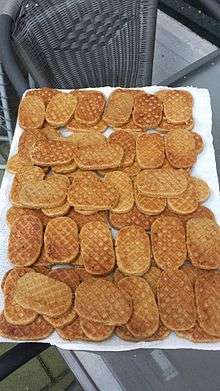Ijzerkoekje
An ijzerkoekje (Dutch pronunciation: [ˈɛizərˌkukjə], 'iron cookie') is a soft cookie, traditionally eaten by Dutch fishermen, especially in Vlaardingen, one of the main harbours of the Netherlands during the 19th and 20th centuries. It is an oval cookie around 0.6-0.7 cm thick with a cinnamon 'creamy' taste. The cookies were invented in the city of Vlaardingen and are baked on a checkered iron plate, creating a characteristic pattern.

Origin
According to oral history, the grocer "Daatje de Koe" (1838–1915) made the first Vlaardingse iron cookies. Afterwards, the product was introduced in the assortment of various city bakers.
Research of the Vlaardingen baker Hazenberg in regional archives showed that the cookie is probably older and dates from the 18th century.[1]
Because of the composition of the dough, the cookies remain tasty for a long time. This made them popular amongst fishermen. These cookies also have a high food energy (calories) value, and have been taken to the sea for that reason, too.
Today, most pastry shops in Vlaardingen sell ijzerkoekjes. Also, special waffle irons are available as well as "ijzerkoekje flour" for baking the cookies at home.
Recipe
The recipe varies, but this is seen as the original of one of the bakeries in Vlaardingen:
- For about 35 cookies it takes:
- 450 grams (16 oz) flour (if possible the Zeeland type of flour, i.e. flour from wheat grown in an oceanic climate zone)
- 325 grams (11.5 oz) white or brown sugar
- 300 grams (11 oz) of butter (or margarine)
- Cinnamon to taste
- Salt
Some opt for relatively more flour and add milk or water, egg or egg yolk, spices, and/or vanilla.
- According to the original recipe, after mixing the ingredients, the dough should rest for half a day in the refrigerator, though not everybody does it.
- Next, roll out the dough, about 6–8 millimetres (0.24–0.31 in) thick, and extend with an iron cookie cutter.
- Then cook on both sides over medium heat on an iron cookies iron, a few minutes per side.
See also
- Stroopwafel – Thin waffle made with caramel syrup filling
References
- Frank Hazenberg (2013) Vlaardingse IJzerkoekjes, no 25 of the publication serie Van ’t Oft naar ’t Ooft, published by the Jan Anderson Streekmuseum, Vlaardingen.